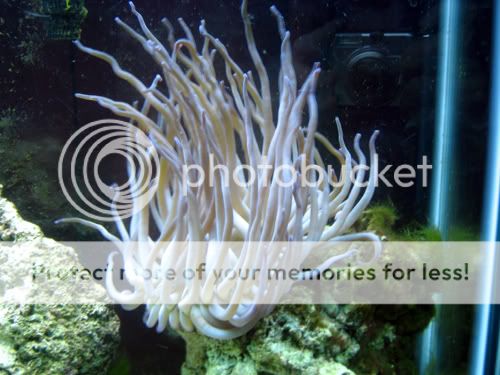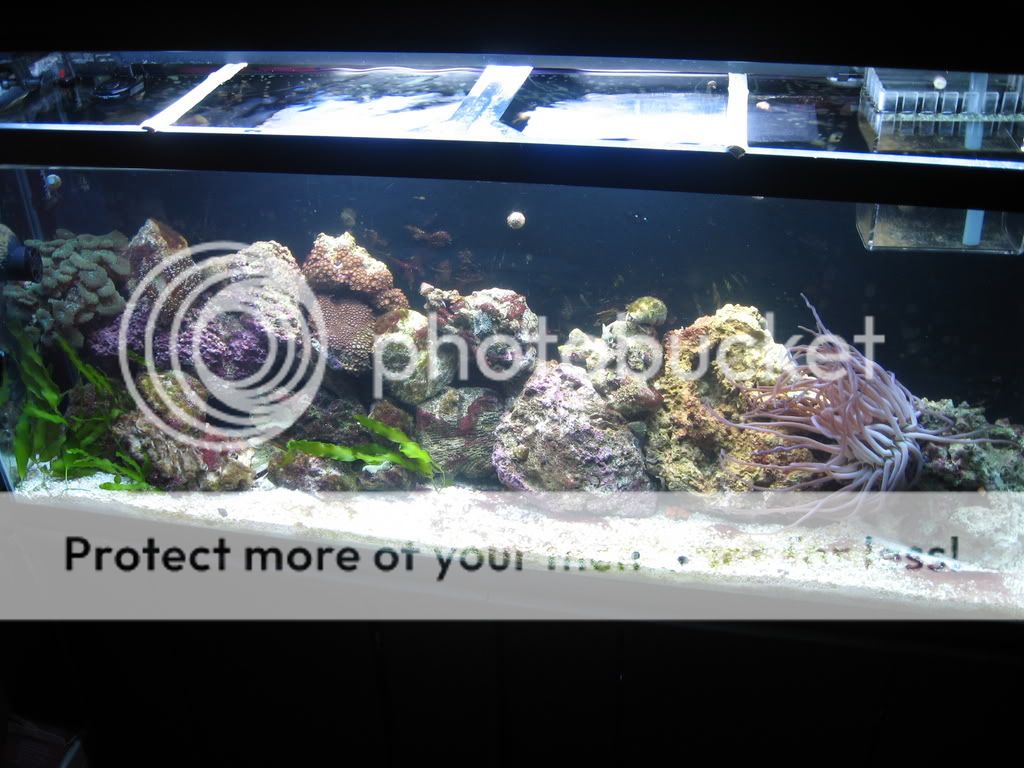chrissaysyes
Nereus
Common Names: Haitian Anemone, Giant Golden Anemone, Purple Tipped Anemone, Giant Carribbean Anemone
Scientific Name: Condylactis gigantea
Family: Actiniidae
Origin: Carribean—West Indies, Western Atlantic.
Size: 6" high, 12" wide, disc diameter approximately 4"; in nature, it can reach 6" high, 12" wide, disc diameter approximately 16".
Acceptable Parameters: Temp: 72-78 degrees; s.g. 1.023-1.024; pH: 8.3; dKh 8-12
Care: The Condy anemone comes in many colors:white, light blue, pink, orange, pale red, or light brown. The mouth of the C. gigantea is surrounded by hundreds of tentacles. Each tentacle is long and tapered with tips that are usually more pale than the body itself. Tip colors range from pink, scarlet, green, and blue. Condys can usually be found attached to hard objects in shallow water that encounters a significant flow of sea water. It is common to reef areas known as "forereef" as well as lagoons and turtle grass beds. They are mostly found as individuals or loose groups, but never as colonies. Condys can develop symbioses with cleaner shrimp, arrow crabs and juvenile wrasse.
Feeding: Like all other anemones, the Condy is carnivorous. They accept a wide array of meaty marine foods. They also rely on an internal symbiosis—much like hermatypic corals—with zooxanthellae. The zooxanthellae provide ample carbon for the Condylactis through the photosynthesis of algae. These organisms can also benefit from the introduction (always MONITORED) of iodine. Mod Note: Iodine is present in three components in sea water: free iodine, iodate and iodide. Kits should test for all three.
The most common method is by means of introducing chopped meaty foods into the tentacles of the anemone via a turkey baster or pipet. NEVER squirt food directly into the mouth of the anemone. It is also an important practice to never give the anemone food pieces that are larger than its mouth to avoid the risk of tearing and damaging the mouth.
Caution:
Photographs:



Scientific Name: Condylactis gigantea
Family: Actiniidae
Origin: Carribean—West Indies, Western Atlantic.
Size: 6" high, 12" wide, disc diameter approximately 4"; in nature, it can reach 6" high, 12" wide, disc diameter approximately 16".
Acceptable Parameters: Temp: 72-78 degrees; s.g. 1.023-1.024; pH: 8.3; dKh 8-12
Care: The Condy anemone comes in many colors:white, light blue, pink, orange, pale red, or light brown. The mouth of the C. gigantea is surrounded by hundreds of tentacles. Each tentacle is long and tapered with tips that are usually more pale than the body itself. Tip colors range from pink, scarlet, green, and blue. Condys can usually be found attached to hard objects in shallow water that encounters a significant flow of sea water. It is common to reef areas known as "forereef" as well as lagoons and turtle grass beds. They are mostly found as individuals or loose groups, but never as colonies. Condys can develop symbioses with cleaner shrimp, arrow crabs and juvenile wrasse.
Feeding: Like all other anemones, the Condy is carnivorous. They accept a wide array of meaty marine foods. They also rely on an internal symbiosis—much like hermatypic corals—with zooxanthellae. The zooxanthellae provide ample carbon for the Condylactis through the photosynthesis of algae. These organisms can also benefit from the introduction (always MONITORED) of iodine. Mod Note: Iodine is present in three components in sea water: free iodine, iodate and iodide. Kits should test for all three.
The most common method is by means of introducing chopped meaty foods into the tentacles of the anemone via a turkey baster or pipet. NEVER squirt food directly into the mouth of the anemone. It is also an important practice to never give the anemone food pieces that are larger than its mouth to avoid the risk of tearing and damaging the mouth.
Caution:
- Like all cnidarians, the Condylactis’ tentacles contain nematocysts. When stimulated these nematocysts will release neurotoxin into the flesh of whatever is touching. This toxin can severely damage nerves in its prey or even in an attacker. It is said that the concentration of this toxin in the Condylactis is not harmful to humans though caution should still be exercised in the event of an allergy.
- Clownfish. No Anemonefish host this anemone in the wild. Therefore it is very difficult to have a Clownfish accept a relationship with a Condylactis. Some aquarists have even reported that their Condy has killed clownfish attempting to host. Mod Note: Clownfish do NOT need an anemone to survive in a marine tank. In fact, they will host in other corals such as Frogspawn and Anchor corals.
- The Condylactis will willingly accept almost anything that enters into its tentacles. In the wild it is not uncommon for them to engage in the capture and devouring of sea urchins. In the aquarium it is important to monitor and control the intake of the Condylactis as in the practice of not being selective, they can damage their mouth which will lead to almost certain death. As mentioned earlier, always make sure food is chopped finely enough to safely be passed into the mouth.
- Like most anemones these do not fall under the reef safe category. It is however, very possible for one to keep these animals in a reef aquarium. I personally have done so for almost a year now. They possess the ability to sting and irritate nearby corals as well as the ability to move around the aquarium. It is possible to determine safe placement of corals based upon the chosen position of the Condylactis. Also, the sting of the Condylactis is not potent enough to immediately kill most soft corals if any. It can irritate them and cause some damage but usually nothing permanent as long as immediate action is taken. OK, Enough of the Mod Notes: Keeping anemones in nano tanks is controversial. Beware of the issues. Like any large marine organism that dies in a small water volume, water quality may degrade rapidly.
Photographs:



